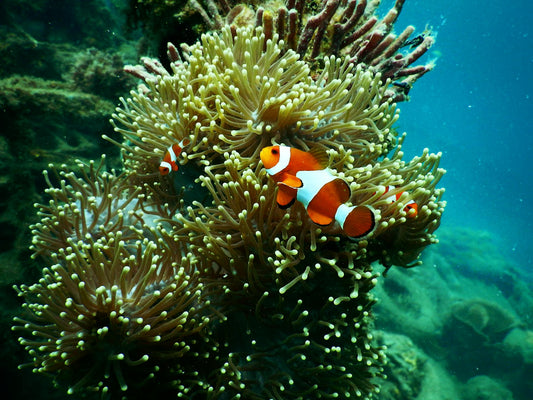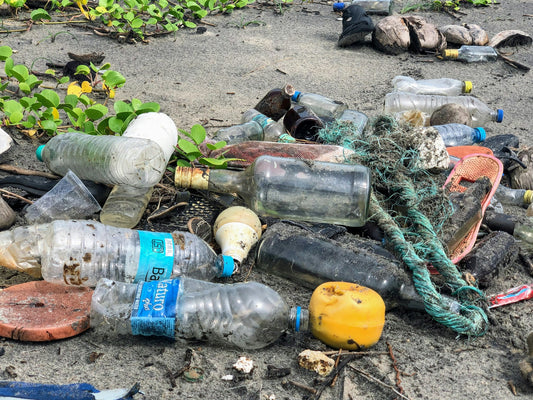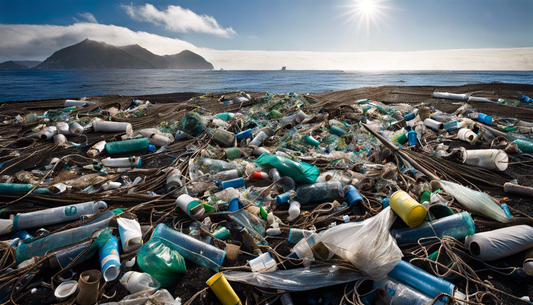Share
Plastic is everywhere, from toys to bottles to clothes, silently infiltrating our lives.
But what if we told you it's also infiltrating our children's health?
Discover the alarming truth about how plastic is impacting the well-being of the little ones we hold dear.
From hormonal disruption to brain damage, to cancer, it's time to face the scary effects that plastic has on our lives.
The hidden dangers of this seemingly harmless material demand our immediate attention. Our children's future depends on it.
1. Hormonal Disruption and Developmental Issues

Unfortunately it is already old news that plastics have already made it into the human body and can even be found in fetus blood.
Plastic contains chemicals that can be especially harmful to children.
Endocrine Disrupting Chemicals (EDC) like are found in many plastic products from protective linings of food cans to toys.
The most famous endocrine disruptor you may have heard of is Bisphenol A (BPA). It has been replaced in many products and companies love to adverstise their products as "BPA-free".
Sadly this label merely qualifies as greenwashing. There is already concerning evidence about similar impacts of its replacements BPS and BPF.
Endocrine disruptors affect how the body produces and spreads hormones.
A disrupted hormonal balance can have detrimental effects on child development, especially in early years.
EDC have been linked to early puperty, hyperactivity, ADHD, underdeveloped brains, and other developmental deficits.
An especially harmful form of EDC are chemicals affecting the so-called thyroid.
The thyroid is a small butterfly-shaped gland in your neck. It produces two hormones (T-4 and T-3), which affect every cell in our bodies. These hormones help regulate how the body uses fats and carbohydrates.
Overxeposure to plastic can disrupt the throid function and lead to severe developmental defects in children. These can span from poor growth and metabolic issues to mental disabilities.
2. Brain Damage

The effects of plastic exposure have also reached our children's brains.There are three main risks that have been surfaced by research.
First, the smaller the plastic particle, the easier it can penetrate biological barriers.
Micro- and nanoplastics have already been found in breast milk, infant blood and, you guessed it, brains.
Wherever plastic is found in the human body, it does not belong there! In tissues, microplastics are seen as foreign bodies. This can cause local immune reactions as the body tries to get rid of the foreign object, causing fever and inflammation.
Second, the chemicals that are deliberately added to plastic can significantly contribute to its toxicity.
Exposure to these chemicals is known to cause nerve damage and cancer.
Third, plastic particles are efficient at absorbing and concentrating pollutants from the environment.
Once contaminated plastic particles enter the human body, the pollutants they have absorbed can be released.
When in contact with bodily fluids, pollutants reach concentrations much higher than those in the surrounding environment.
These negative effects can lead to brain development issues, permanent brain damage, and even Alzheimer and Parkinson's.
3. Lung Damage

Plastic, especially in the form of micro- and nanoplastic can cause severe lung damage.
Mid 2022, UK researchers published a study that found microplastic deep in the lungs of living humans.
This finding was especially alarming, because the researchers had assumed that plastic particles would be filtered out in the deep areas of the lung.
Other studies with textile workers that process polyester and other microfibers show that many suffer breathlessness, couching and a reduced lung capacity.
There is general consensus among researchers that inhaled microplastic can impact the general lung capacity, cause inflammation and lead to respiratory diseases like asthma and lung cancer.
Another concern related to plastic and lung damage is the toxic fumes that are created when plastic is burned.
Short-term exposure to these fumes can cause breathing problems, coughing and inflammation. Long-term exposure can cause chronic lung diseases.
While this is especially harmful to children directly exposed to trash fires due mismanaged waste, it can affect all of us.
Incineration is a regular waste management practice in many countries and the effects on local air quality in the vicinity of waste management plants are alarming.
4. Immune System Disruption

Growing up, a strong immune system is the prerequisite to our kids' life adventures.
Unfortunately, plastic is known to impair the development and function of the immune system.
A recent study by researchers at the French National Centre for Scientific Research showed that white blood cells behave differently when exposed to small plastic particles.
The study indicates that micoplastic particles can "distract" the white blood cells. This limits the body's ability to fight other intruders like viruses or bacteria.
Additionally, microplastics can also introduce bacteria that the body would not usually be exposed to.
As we already mentioned above, if plastic is ingested, it comes with a plethora of toxins and bacteria. These substances can have wider effects on the immune system and permanently damage cells.
5. Cancer
While we already touched on cancer above, it surely deserves its own category.
A recent report from late 2023 compares 120 scientific studies and paints a gloomy picture about the conection between plastic and cancer.
- Plastic exposure increases the risk of leukemia, lymphoma, brain cancer, and breast cancer.
- Plastic can be connected to an increased risk of mesothelioma, an aggressive cancer that can affect lungs, abdomen, heart and testes. It was previously mainly connected to asbestos.
- Plastic is linked to increased rates of cardiovascular disease, toxic metal poisoning, neuropathy, and lung cancer.
- Residents of communities adjacent to plastic production and waste disposal sites experience increased risks of childhood leukemia and lung cancer
- Exposure to phthalates, a chemical used in many plastics, is associated with a 20% higher rate of childhood cancer overall.
- Contact with these chemicals is linked to a nearly three-fold higher rate of bone cancer and a two-fold higher rate of lymphoma, a cancer of the blood.
We Need to Protect Our Children
In realizing the hidden dangers of plastic, the urgency to protect our children should be crystal clear.
Plastic poses serious threats. It disrupts kids' hormones and damages their developing brains. It causes lung issues and weakens their immune systems.
The alarming link to cancer further emphasizes the urgency of the situation.
It's time for action!
By drastically reducing plastic use, advocating for better waste management, and demanding stricter regulations, we can demad a healthier future for our children.
Let's unite to create a world where their innocence is preserved, and their well-being is safeguarded.
The power to shape a safer future for our kids lies in our hands, and the time for change is now.
We hope you enjoyed this article. If you want to read more like this, make sure to check out our Blog and follow us on Instagram. If you are interested in truly sustainable products, check out our Shop.
If you want to engage in the discussion, feel free to leave a comment below.








